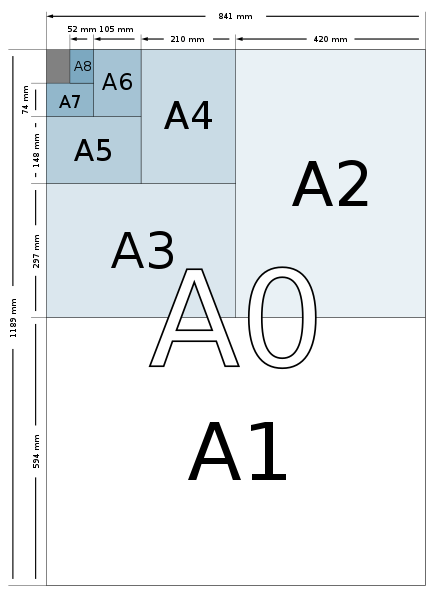What Is an A4 Paper?
A4 paper is a standardized paper size that falls under the ISO 216 international standard for paper sizes. This standard is used worldwide except in North America and parts of Latin America, which use different sizes like "Letter" and "Legal". ISO 216 defines A and B series. The A series defines sizes A0 to A10. A0 is the biggest one with an area of nearly 1 square meter, while the A10 is the smallest size. Among them, the A4 paper is the most commonly available and the most used size around the world. Its dimensions are 210 mm × 297 mm (8.3 in × 11.7 in).
Applications of A4 Paper Size
A4 paper is recommended as the standard paper size for business, administrative and government correspondence. It is also the most used paper size for home printers.
Properties and Advantages of ISO 216 Standard
The aspect ratio of all sizes in the A and B series is √2:1(square root of 2). The reason for choosing this ratio is when the long side of such rectangles is cut or folded in half, the resulting halves also have the same aspect ratio. This property is unique to square root of 2. As a result, each ISO paper size is approximately one half of the area of the next larger size in the same series, i.e., area of the A5 paper is about half of the area of A4 with the same aspect ratio.
The main advantage of this system is its scalability, which means you can easily create larger and smaller sheets using papers of other sizes when one exact size is not available. This makes common office tasks, such as photocopying, printing, etc., convenient. You can make larger and smaller papers without producing waste paper. In order to make a large standard paper, one can stick two papers that are one size smaller, along their length. Likewise, in order to create two smaller papers, all you need is folding or cutting a larger one in half, in the middle of its length.
You can compare different sizes of A series in the following figure.

Another advantage of this system, is the ease of calculating the weight of sheets. Paper's weight is defined (ISO 536) as the sheet's mass in grams per square meter (gsm or g/m2). Therefore, one can calculate the weight of the sheets by simple division. For example, an A4 sheet of made from 80 gsm paper, weighs 5 grams, as it is 1⁄16 (four halvings, ignoring rounding) of an A0 page. Isn't it neat? One can multiply this by the number of sheets in a quire, a ream, a bundle or a pallet of paper to obtain a rough estimate of the postage rate.
The table below lists all dimensions of A, B and C series. The C series was defined in ISO 269 which is a withdrawn standard, meaning it is no longer used.
| e | A series formats | B series formats | C series formats | ||||||
|---|---|---|---|---|---|---|---|---|---|
| name | mm | inches | name | mm | inches | name | mm | inches | |
| -2 | 4A0 | 1682 × 2378 | 66.2 × 93.6 | ||||||
| -1 | 2A0 | 1189 × 1682 | 46.8 × 66.2 | ||||||
| 0 | A0 | 841 × 1189 | 33.1 × 46.8 | B0 | 1000 × 1414 | 39.4 × 55.7 | C0 | 917 × 1297 | 36.1 × 51.1 |
| 1 | A1 | 594 × 841 | 23.4 × 33.1 | B1 | 707 × 1000 | 27.8 × 39.4 | C1 | 648 × 917 | 25.5 × 36.1 |
| 2 | A2 | 420 × 594 | 16.5 × 23.4 | B2 | 500 × 707 | 19.7 × 27.8 | C2 | 458 × 648 | 18.0 × 25.5 |
| 3 | A3 | 297 × 420 | 11.7 × 16.5 | B3 | 353 × 500 | 13.9 × 19.7 | C3 | 324 × 458 | 12.8 × 18.0 |
| 4 | A4 | 210 × 297 | 8.3 × 11.7 | B4 | 250 × 353 | 9.8 × 13.9 | C4 | 229 × 324 | 9.0 × 12.8 |
| 5 | A5 | 148 × 210 | 5.8 × 8.3 | B5 | 176 × 250 | 6.9 × 9.8 | C5 | 162 × 229 | 6.4 × 9.0 |
| 6 | A6 | 105 × 148 | 4.1 × 5.8 | B6 | 125 × 176 | 4.9 × 6.9 | C6 | 114 × 162 | 4.5 × 6.4 |
| 7 | A7 | 74 × 105 | 2.9 × 4.1 | B7 | 88 × 125 | 3.5 × 4.9 | C7 | 81 × 114 | 3.2 × 4.5 |
| 8 | A8 | 52 × 74 | 2.0 × 2.9 | B8 | 62 × 88 | 2.4 × 3.5 | C8 | 57 × 81 | 2.2 × 3.2 |
| 9 | A9 | 37 × 52 | 1.5 × 2.0 | B9 | 44 × 62 | 1.7 × 2.4 | C9 | 40 × 57 | 1.6 × 2.2 |
| 10 | A10 | 26 × 37 | 1.0 × 1.5 | B10 | 31 × 44 | 1.2 × 1.7 | C10 | 28 × 40 |
1.1 × 1.6 |
Difference between A, B and C Series?
B Series
The B series paper sizes are less commonly used than the A series. Although they have the same aspect ratio of √2:1(square root of 2), their area is different from A series. Each size in B series is the geometric mean of two successive sizes of A series. For example, the area of B1 paper is smaller than A0, but larger than A1. The length of the B0 size is 1 meter (1000 millimeters) and its width is 1.414 meters (1414 millimeters).
Having said that, B series is used where one size of the A series would be too small, but its next size would be too large. Examples from Wikipedia:
- B4, B5, and B6 are used for envelopes that will hold C-series envelopes.
- B4 is quite common in printed music sheets.
- B5 is a relatively common choice for books.
- B7 is equal to the passport size ID-3 from ISO/IEC 7810.
- Many posters use B-series paper or a close approximation, such as 50 cm × 70 cm ~ B2.
In general, the B-series is mostly used in the printing industry, both in printing presses and digital presses.
C Series
The C series is defined in ISO 269, which was withdrawn in 2009 without a replacement, but it is still specified in several national standards. It is primarily used for envelopes. The area of C series sheets is the geometric mean of the areas of the A and B series sheets of the same number; for instance, the area of a C4 sheet is the geometric mean of the areas of an A4 sheet and a B4 sheet. This means that C4 is slightly larger than A4 and slightly smaller than B4. The practical usage of this is that a letter written on A4 paper fits inside a C4 envelope, and both A4 paper and a C4 envelope fit inside a B4 envelope.
Paper Density and Thickness—Are They Related?
Maybe, but not necessarily. The detailed answer follows.
Paper manufacturing, simply put, is the process of whitening and pressing wood pulp together to form paper sheets. The more paper pulp pressed together, the higher the fiber density of the sheets and its weight (gsm). For example, more pulp is needed to make an A0 sheet of 80 gsm than is needed to make an A0 sheet of 70 gsm. Additionally, to make the surface of the sheets smooth and appropriate for printing and other applications, the paper sheets are run through one or more stages of hard-pressed rollers (calenders). This process is called calendering. The result of calendering is smoother paper sheets. However, this mechanical pressure reduces the thickness of the sheets, but the weight (and thus the gsm) remains unchanged, because the amount of pulp in the sheet stays the same. This means two sheets of paper can have the same gsm but different thicknesses. In general, it can be said that the thickness of papers of the same type (matte vs. glossy) from the same brand and production batch can be compared by their gsm; though, if the type, manufacturer, brand, or production batches of two papers are different, then the above does not hold true.
Where to Buy?
You can buy different types of A4 paper, both in wholesale bulk and individual retail quantities in the "Office Supplies" section of the MCR Snack Distro website at the most affordable prices across UK, with your order delivered in shortest time possible.






